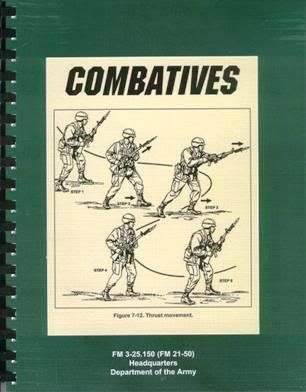 Before hordes of BJJ and Army MACP proponents come knocking on my door looking to roll, let me caution you that I write this from the perspective of someone who is not a grappler, but an interested party - interested in seeing whether it's effective for street combat, or can get you hurt. I have no intention of competing in tournaments or other mixed competitions, but I do want to make sure my students and I survive for as long as possible. We have previously posted on the controversy of whether it's even appropriate to build a grappling mentality and muscle memory for soldiers that may will have to use this on the battlefield. That said, I am beginning a series on what seems to work and not work for us, and why. It may work for you, but your skill levels and goals may be different. So stay tuned for more. I will ask my boys here to comment and post as well, and will update these posts. First of all, we are using two sources of training material: the U.S. Army FM 3-25.150 (FM 21-150) manual and a video entitled MACPModernArmyCombativesProgram.wmv. They are, at this point the only source of information. I will rely on our readers to post in Comments your opinions and corrections. You may also email them to me, but keep in mind I may edit and post them unless you instruct otherwise. So here we go. Initial critique of the manual - you can't always tell who the uke and tori are due to both being in the same pattern BDU/camo. The Marine Corps at least had desert and forest to differentiate by shade, so it was a little easier. Also, more reasons could be given for a particular variant or detail could be given. Otherwise, the written documentation of each technique is very good.
Before hordes of BJJ and Army MACP proponents come knocking on my door looking to roll, let me caution you that I write this from the perspective of someone who is not a grappler, but an interested party - interested in seeing whether it's effective for street combat, or can get you hurt. I have no intention of competing in tournaments or other mixed competitions, but I do want to make sure my students and I survive for as long as possible. We have previously posted on the controversy of whether it's even appropriate to build a grappling mentality and muscle memory for soldiers that may will have to use this on the battlefield. That said, I am beginning a series on what seems to work and not work for us, and why. It may work for you, but your skill levels and goals may be different. So stay tuned for more. I will ask my boys here to comment and post as well, and will update these posts. First of all, we are using two sources of training material: the U.S. Army FM 3-25.150 (FM 21-150) manual and a video entitled MACPModernArmyCombativesProgram.wmv. They are, at this point the only source of information. I will rely on our readers to post in Comments your opinions and corrections. You may also email them to me, but keep in mind I may edit and post them unless you instruct otherwise. So here we go. Initial critique of the manual - you can't always tell who the uke and tori are due to both being in the same pattern BDU/camo. The Marine Corps at least had desert and forest to differentiate by shade, so it was a little easier. Also, more reasons could be given for a particular variant or detail could be given. Otherwise, the written documentation of each technique is very good.
What we have learned so far:
- Breakfalls: no fundamental difference from the basics of Judo/traditional JJ, Hapkido, etc.
- Closing the distance, Achieving the clinch: seems fine, and useful
- Front takedown (from the clinch): again, useful
- Rear takedown from a side or rear position in the standing clinch: very useful, and easy to execute. I have adapted this to my standing Thai clinch defense, and we've drilled it. I may do an instructional post on that later.
- Hip throw: an excellent technique, but it takes more technique and timing. The added benefit is that, if well executed, it may finish the encounter without further hands-on negotiation.
Check back to this post (and the rest in the series). I add links to video or still photos of most of the techniques - even the ones we have a problem with (from a practical perspective).

No comments:
Post a Comment